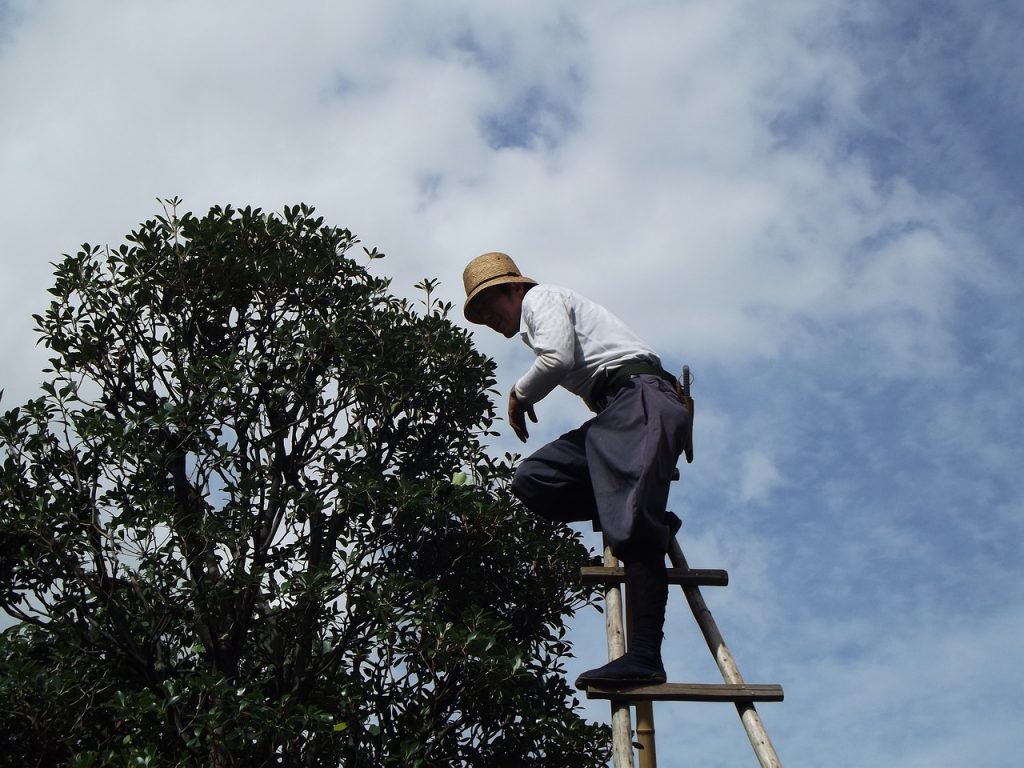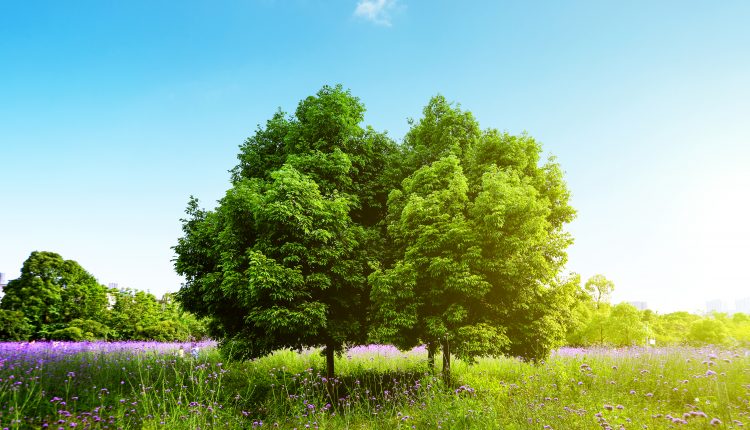PREVENTING WILDFIRES WITH PROPER TREE CARE
Preventing wildfires with proper tree care involves implementing specific practices that reduce the risk of wildfires igniting, spreading, and causing damage. Trees can contribute to the ignition and rapid spread of wildfires, especially when they are not well-maintained or situated close to structures. Proper tree care focuses on creating defensible space, reducing potential fuels, and promoting healthy tree growth. Here’s an explanation of how proper tree care can help prevent wildfires:

- Defensible Space Creation: Proper tree care includes creating defensible space around buildings and structures. This involves clearing away dead leaves, branches, and other debris that can act as fuel for wildfires. By creating a buffer zone, you reduce the risk of fire spreading to your property.
- Pruning and Limbing Up: Pruning involves removing lower branches of trees to prevent the “ladder effect.” This effect occurs when fire can climb from ground-level vegetation to the tree canopy. Proper pruning reduces ladder fuels and prevents fire from reaching the upper parts of trees, reducing the risk of crown fires.
- Removing Dead or Diseased Trees: Dead or diseased trees are more susceptible to ignition and can quickly become fuel for wildfires. Removing such trees eliminates potential fire hazards and reduces the risk of fire spreading to healthier vegetation.
- Proper Tree Placement: The placement of trees near structures plays a role in wildfire prevention. Trees with overhanging branches close to buildings can act as fire pathways. Proper tree placement involves maintaining safe distances from structures and ensuring that tree canopies do not touch roofs or walls.
- Collaboration with Certified Arborists and Fire Professionals: Certified arborists and fire professionals can provide expert guidance on creating effective wildfire prevention strategies. Arborists assess tree health, recommend pruning, and help with tree removal. Fire professionals can provide insights into creating defensible spaces and managing vegetation to reduce fire risk.
- Community Education and Engagement: Educating homeowners and communities about the importance of proper tree care in wildfire prevention is crucial. Awareness campaigns and workshops can empower individuals to take proactive steps to protect their properties.
- Fire-Resistant Landscaping Practices: Incorporating fire-resistant plants and materials in your landscaping can reduce the risk of ignition. Choose plants with low flammability, create firebreaks, and use non-combustible materials near structures.
- Compliance with Local Regulations: Many areas have fire ordinances and regulations that require proper vegetation management. Adhering to these guidelines not only reduces your risk but also contributes to community-wide wildfire prevention efforts.
- Overall Impact: Proper tree care reduces the amount of potential fuel available for wildfires and minimizes the likelihood of fires starting or spreading. It also improves the overall health of trees, making them more resilient to environmental stresses.
In conclusion, preventing wildfires with proper tree care is a proactive approach to protecting properties, communities, and natural environments. By following recommended practices and collaborating with experts, individuals can significantly contribute to reducing the risk of wildfires and ensuring the safety of their surroundings.
Role of Proper Tree Care in Wildfire Prevention
Proper tree care plays a significant role in wildfire prevention by reducing the risk of fires igniting, slowing down their spread, and minimizing the potential damage they can cause. Trees, when not properly managed, can contribute to the ignition and rapid propagation of wildfires. By implementing specific tree care practices, individuals can create defensible spaces, reduce fuel sources, and promote healthier landscapes that are less susceptible to wildfires. Here’s how proper tree care contributes to wildfire prevention:

- Defensible Space Creation: Proper tree care involves creating defensible spaces around homes, buildings, and structures. This space acts as a buffer zone that reduces the risk of wildfire spreading to your property. By removing dead leaves, branches, and other combustible materials, you create a barrier that can slow down the advance of flames.
- Ladder Fuel Reduction: Ladder fuels are vegetation that allows fire to climb from ground-level plants to tree canopies. Proper pruning and limbing up remove lower branches, reducing the ladder effect. This prevents fires from reaching the tree crowns, where they can spread more rapidly and intensify.
- Dead Wood Removal: Dead or dying trees and branches are more susceptible to ignition. Removing these dead materials eliminates potential fuel sources for wildfires. By taking proactive steps to identify and remove dead wood, you reduce the risk of fires starting or spreading through these materials.
- Proper Placement of Trees: The positioning of trees near structures is crucial for wildfire prevention. Trees with branches overhanging roofs or touching walls can provide a direct pathway for fire to spread. Proper tree placement ensures that canopies are not in direct contact with structures, reducing the likelihood of fire transmission.
- Collaboration with Professionals: Certified arborists and fire professionals can provide expert insights into creating effective wildfire prevention strategies. Arborists assess tree health, recommend pruning or removal, and contribute to overall landscape health. Fire professionals offer guidance on creating defensible spaces and managing vegetation to reduce fire risk.
- Reduced Fire Intensity: Properly cared-for trees are less likely to catch fire and can even act as barriers to the spread of flames. Trees with healthy foliage and well-pruned canopies are less likely to ignite and contribute to the overall intensity of a wildfire.
- Education and Community Engagement: Educating homeowners and communities about the importance of proper tree care in wildfire prevention fosters a collective understanding of the role trees play in fire risk. Community-wide efforts can lead to more effective and comprehensive wildfire prevention strategies.
- Overall Landscape Health: Proper tree care promotes the overall health of trees and vegetation. Healthy trees are more resilient to environmental stresses, including fire. They are better equipped to recover from fire-related damage and are less likely to become sources of ignition.
In summary, proper tree care is a proactive and crucial component of wildfire prevention. By creating defensible spaces, reducing ladder fuels, removing dead materials, and collaborating with experts, individuals can significantly decrease the risk of wildfires and their potential impact on lives, properties, and natural ecosystems.
Role of Proper Tree Care in Wildfire Prevention
Proper tree care plays a crucial role in wildfire prevention by mitigating the factors that contribute to the ignition and spread of wildfires. Trees can act as fuel for fires, and their condition and placement can greatly influence the risk of wildfires. Implementing appropriate tree care practices helps reduce the likelihood of fires starting, slows down their spread, and minimizes their overall impact. Here’s how proper tree care contributes to wildfire prevention:
- Fuel Reduction: Proper tree care involves removing dead, diseased, or overgrown vegetation that can serve as fuel for wildfires. By reducing the availability of combustible materials, the chances of fires igniting and spreading are significantly diminished.
- Creating Defensible Space: Properly caring for trees includes creating defensible space around structures. This involves clearing away flammable debris, pruning branches near buildings, and maintaining a zone where the intensity of fires can be reduced, giving firefighters a better chance to control the blaze.
- Ladder Fuel Management: Trees with lower branches that touch the ground or neighboring plants can create a “ladder” for fire to climb from the ground to the tree canopy. Proper pruning and removing lower branches help break this ladder effect and prevent fires from reaching the tree crowns.
- Dead Wood Removal: Dead trees, branches, and accumulated dead material on the ground are highly flammable and can serve as ignition sources for fires. Removing these materials reduces the risk of fires starting and limits the spread of existing fires.
- Proper Placement: Thoughtful tree placement is essential for reducing fire risk. Trees too close to structures or power lines can facilitate fire spread. Properly spaced and well-maintained trees minimize the potential for fires to reach buildings and infrastructure.
- Reduced Fire Intensity: Well-maintained trees are less likely to catch fire and spread flames. Trees with healthy canopies and pruned branches are less combustible, which in turn reduces the intensity of a wildfire.
- Collaborating with Professionals: Certified arborists and fire experts can provide valuable insights into tree health, fire behavior, and effective preventive measures. Arborists can recommend proper pruning techniques, and fire professionals can help design effective defensible space plans.
- Community Education: Educating communities about the importance of proper tree care in wildfire prevention fosters a collective effort to create fire-resistant landscapes. When individuals understand their role in fire prevention, they are more likely to take proactive measures.
- Overall Landscape Resilience: Properly cared-for trees are more resilient to stressors, including wildfires. Healthy trees are better equipped to survive fires, recover more quickly, and contribute to the overall ecosystem’s recovery.
Factors That Make Trees Susceptible to Wildfires
Several factors contribute to making trees more susceptible to wildfires. These factors increase the likelihood of trees igniting, facilitating the spread of fires, and potentially exacerbating the overall impact of wildfires. Recognizing these factors is crucial for understanding the role trees play in fire-prone environments and implementing effective wildfire prevention strategies. Here are some key factors that make trees more susceptible to wildfires:

- Dead and Dry Vegetation: Dead leaves, twigs, branches, and fallen debris create fine fuels that can easily ignite and contribute to the rapid spread of fires. Dry vegetation is highly flammable and acts as a ready source of fuel.
- Dense Understory and Overgrowth: An overgrown understory with accumulated dead materials provides pathways for fire to climb up to the tree canopy. Dense vegetation also allows fire to spread quickly between trees.
- Accumulation of Ladder Fuels: Ladder fuels are lower branches and shrubs that can carry fire from the ground to the tree crowns. These fuels create vertical pathways for fire to reach the upper parts of trees.
- Bark Characteristics: Some tree species have bark that is more prone to ignition, such as thin or flaky bark. Bark can serve as a conduit for fire to travel into the tree’s interior.
- Resin and Volatile Compounds: Trees containing resinous substances or volatile compounds are more likely to ignite and burn intensely. These compounds can create highly flammable conditions.
- Dead or Diseased Trees: Dead or diseased trees have reduced water content and are more susceptible to ignition. Their dry condition makes them vulnerable to becoming sources of fire spread.
- Proximity to Structures and Infrastructure: Trees located too close to buildings, power lines, and other structures increase the risk of fire transmission. Flames can leap from trees to structures, facilitating fire’s advance.
- Invasive Species: Invasive plants can alter ecosystems, increase fuel loads, and create conditions that are more conducive to fire spread.
- Environmental Stressors: Environmental stressors such as drought, high temperatures, and low humidity can lead to tree dehydration and increased flammability.
- Poor Tree Health: Trees weakened by pests, diseases, or other stressors are less capable of resisting fires. Their compromised health makes them more susceptible to ignition.
- Accumulation of Debris: Accumulated leaf litter, dead branches, and other debris create a continuous source of fuel on the forest floor.
- Forest Management Practices: Poor land management, including lack of thinning or prescribed burns, can lead to overcrowded and unhealthy forests that are more prone to wildfires.
- Human Activities: Careless behavior, such as discarded cigarette butts, campfires left unattended, and equipment use near dry vegetation, can lead to accidental fires that spread to trees.
- Ignition Sources: Lightning strikes, power lines, and sparks from machinery can serve as ignition sources for trees that are already vulnerable due to other factors.


Comments are closed.